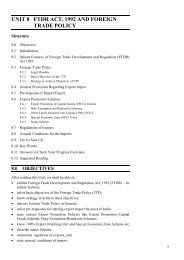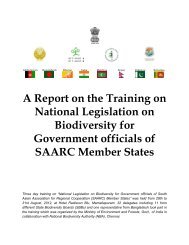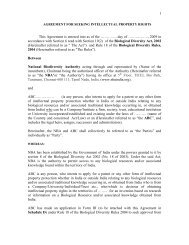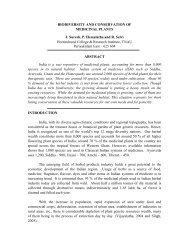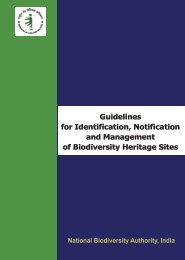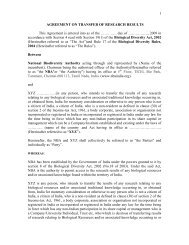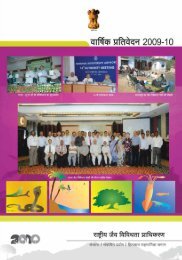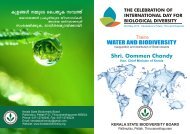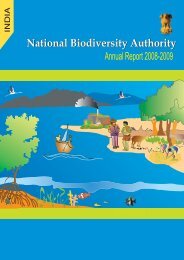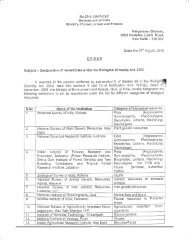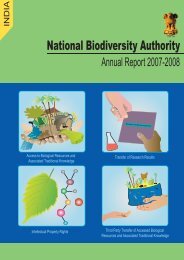BCIL BOOK.pmd - National Biodiversity Authority
BCIL BOOK.pmd - National Biodiversity Authority
BCIL BOOK.pmd - National Biodiversity Authority
You also want an ePaper? Increase the reach of your titles
YUMPU automatically turns print PDFs into web optimized ePapers that Google loves.
NATIONAL BIODIVERSITY ACTION PLAN<br />
development of forest villages to raise Human<br />
Development Index, and 100% central grants-in-aid<br />
to States under Article 275(1) of the Constitution.<br />
The <strong>National</strong> Rural Employment Guarantee Act,<br />
2005 entitles a rural household for 100 days of work<br />
in a financial year. Many of the works permissible relate<br />
to forestry, like afforestation, tree plantation, water<br />
conservation and water harvesting, etc.<br />
Pressure on natural resources in biodiversity-rich<br />
areas needs to be diverted by bringing additional areas<br />
under green cover to satisfy local demands,<br />
encouraging environment-friendly substitutes to meet<br />
the needs, promoting energy efficient devices, and<br />
creating awareness and an enabling environment.<br />
There is also a need to devise techniques/tools to<br />
restrict use and extraction of only desired part of the<br />
organism rather than the entire organism.<br />
Economically effective and socially viable<br />
incentives for conservation and sustainable use of<br />
biological diversity are being encouraged. These<br />
include use of wood substitutes, alternative energy<br />
sources (biogas, wind mills, solar cookers, wave energy,<br />
fuel efficient stoves, etc.), establishment of nurseries,<br />
tree planting, stall feeding, water harvesting and<br />
pollution abatement measures.<br />
The forestry sector in India is being reoriented with<br />
growing emphasis on poverty alleviation and livelihood<br />
opportunities, while at the same time ensuring<br />
sustainable management and use of forest resources.<br />
The current trend in forest management is towards<br />
greater participation and involvement of all<br />
stakeholders dependent on the forests. The <strong>National</strong><br />
Forest Policy (1988) and <strong>National</strong> Forestry Action<br />
Programme (1999) also endeavour to address some<br />
of the concerns towards Sustainable Forest<br />
Management (SFM). According to <strong>National</strong> Status<br />
Report on Forests and Forestry in India, 2006, SFM<br />
would, inter alia, involve:<br />
<br />
<br />
Production of wood and non-timber forest<br />
products, first for meeting subsistence needs<br />
and then the surplus for commercial purposes.<br />
Protection and setting aside of areas to be<br />
managed as wild life reserves or plantations<br />
for recreational and<br />
environmental<br />
purposes.<br />
Regulating the<br />
conversion of<br />
forest lands for<br />
non-forestry uses.<br />
Regeneration of<br />
wastelands and<br />
degraded forests.<br />
Functional and land capability classification<br />
of forests and land use planning to ensure<br />
healthy and sustainable land use systems with<br />
acceptable safe minimum standards.<br />
Protection of adequate extent of natural<br />
forests for their long-term contributions<br />
including conservation of biodiversity.<br />
Management and utilization of forest<br />
resources for maximizing their sustainable<br />
contribution and value addition towards<br />
improved welfare of society.<br />
Promotion of efforts for producing forest<br />
goods and services outside forest areas (e.g.<br />
agroforestry plantations, home gardens) and<br />
development of potential substitutes for<br />
wood from non-forest sources (e.g. rubber<br />
wood, coconut wood).<br />
Waste reduction and recycling programme.<br />
Feasible medium for encouraging<br />
participation of people and the private sector.<br />
A proper and realistic system for cost, values<br />
and benefits attributable to forestry to ensure<br />
a strong ecology - economy interface.<br />
The Joint Forest Management (JFM) programme<br />
in the country has emerged as a powerful tool to<br />
achieve sustainable management of forestry in India.<br />
A decentralized two-tier institutional structure [Forest<br />
Development Agency (FDA) and JFM Committee]<br />
facilitates greater participation of the local<br />
communities, both in planning and implementation,<br />
to conserve forests as well as secure livelihoods. At<br />
present, more than 22.02 million ha of forests are<br />
managed by around 1.06 lakhs JFM Committees<br />
34



